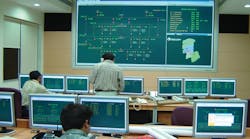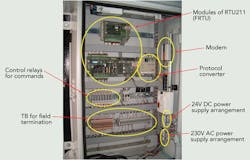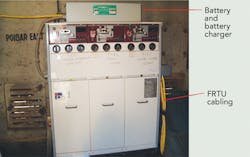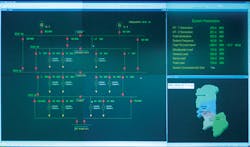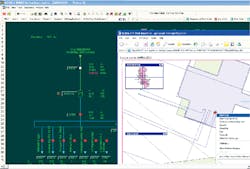Reliance Infrastructure Ltd., India’s largest vertically integrated private power distributor, generates, transmits and trades the energy produced by its power plants. As the leading private utility in transmission and distribution in India, it distributes power to 5.2 million customers across India, including low-voltage services to two-thirds of the homes in Delhi and Mumbai.
The Reliance Infrastructure (RInfra) network in Mumbai consists of one power plant with a total installed capacity of 500 MW. The utility’s 220-kV transmission network is 650 km (404 miles) long, its 11-kV distribution network extends 2,750 km (1,709 miles) and its 0.415-kV network is 5,350 km (3,324 miles) long. The peak demand on the system in Mumbai is 1,674 MW. To satisfy this demand and that of its customers in other regions of India, RInfra is a net purchaser of energy.
As electricity consumption increases, RInfra’s biggest challenge to satisfy the peak demand has centered on improving system availability and reliability. Traditionally, the energy losses on the Mumbai and Delhi distribution networks have been greater than 30%, necessitating a focused response to improve the performance of this last sector in RInfra’s power supply chain. The main causes of these excessively high distribution losses are attributable to both technical and commercial standards. The challenge to reduce these losses is to increase the capital investment in the low-voltage distribution network and improve operational reliability.
Identifying the Problem
RInfra’s power supply chain has a singular goal to reduce both planned and unplanned network outages. The distribution operation strategies identified to achieve this objective are to improve outage restoration, reduce load shedding and maintain voltage-profile consistency.
Formerly, RInfra’s 11-kV outage management system was a stand-alone manual system, largely dependent on the experience and efficiency of the field crews dispatched to identify the fault location and undertake the necessary restoration work. The lack of an intelligent system to identify the fault location increased supply restoration times.
With significant growth opportunities and market presence at stake, RInfra sought a proven and robust enterprise solution for its control room operations with advanced distribution management applications and enhanced human-machine interface (HMI) features.
Selecting a Solution and a Provider
To increase reliability, visibility and control of its 11-kV distribution network, RInfra decided to procure and install feeder remote terminal units (FRTUs) in the distribution substations equipped with ring main units (RMUs). This established network design feature facilitates uninterrupted power supplies through alternative circuits. In parallel with the planned operational improvements, key business processes such as those used to integrate with the interstate and intrastate availability-based tariff (ABT) system were targeted for optimization.
To implement the required solutions and improve network performance, RInfra circulated an international tender that generated bids from several automation equipment manufacturers. RInfra selected Ventyx, an ABB company, based on its solution and cost to provide and install a supervisory control and data acquisition/distribution management system (SCADA/DMS).
Implementing a SCADA/DMS System
Based on previous in-house experience implementing SCADA, RInfra modernized its distribution operations to accept the highly integrated Network Manager SCADA and DMS solution from Ventyx. The system delivers real-time monitoring and control alongside advanced network applications to RInfra’s distribution network, promoting an able environment to address its key challenges.
Complementing full SCADA functionality, the enterprise solution incorporates advanced distribution applications to optimize network use, among them fault location, isolation and system restoration (FLISR), load flow calculations and volt/VAR control. The modern SCADA solution provides a more accurate representation of the as-operated electrical distribution network, while robust distribution capabilities have improved the accuracy and reduced the time taken for fault-zone determination, isolation and restoration of RInfra’s medium-voltage distribution network.
The solution includes main and redundant control center systems, which enable operations to switch from the main to the redundant control center when there is a complete breakdown of the main control center. The redundant control center is an exact replica of the main control center in terms of the hardware and software applications installed. The system also has web-based monitoring of the SCADA displays and events, which are accessed by personnel outside the control center through RInfra’s corporate local area network/wide area network. Firewalls with clearly defined access policies were configured to provide secured access to these remote users.
In addition, the solution is designed with an isolation scheme intended to mitigate power disturbances by enabling each distribution point to receive power from either direction in the case of a fault. The advantage of this multidirectional power flow design is attributable to the high reliability delivered by multiple power sources. FRTUs also are installed to monitor the fault indications along sections, facilitating faster identification of faults and power restoration on non-faulty sections through the alternative sections of the network.
The solution is integrated with other enterprise systems such as RInfra’s geographical information system, which enables more efficient use of the DMS capabilities, and the utility’s state load dispatch center, which facilitated the implementation of the ABT mechanism and enables the optimization of the utility’s related business processes.
Integrating DMS
The entire system including all integration was commissioned in 2007-2008. Because its entire network operations are dependent on SCADA/DMS, the utility has established a system maintenance support contract with Ventyx. This enables high availability of the system through on-site and remote diagnostics support.
It was important to migrate from the previous system to the new one with minimal impact and to deliver a familiar interface that control center operators could adopt easily. Ensuring a clear understanding of the system’s operation also was key to accelerating the adoption of new features. These deployment goals were accomplished with a joint, dedicated RInfra-Ventyx implementation team, a professional training curriculum and targeted system testing.
Recognizing Benefits
The availability of important real-time information from the generation, transmission and distribution networks in one centralized location has enabled quick decision making for RInfra during major grid failures and other faults. The system has proven to be highly reliable with the operations team being fully dependent on SCADA for daily operations and network analysis. The user-friendly displays at the operator workstations have further helped system control engineers to operate the geographically scattered elements of the distribution network with ease.
RInfra’s distribution network has achieved significant operational gains:
- Fault-restoration times have been reduced by 45%.
- Overall, the distribution network losses on RInfra’s Mumbai network have been reduced from 10.9% in 2007 to 9.13% in 2011 and are now among the lowest in the country. This has been achieved by closely monitoring the voltage profiles, capacitor switching and load-transfer operations through SCADA/DMS. Also, RInfra has commissioned automatic power-factor control panels on the distribution network to reduce losses even further.
- Customer average interruption duration index (CAIDI) has been reduced by quickly identifying and isolating the faulty sections and restoring the healthy sections from the SCADA control center.
- Asset life has been extended by protecting generation plants at Dahanu, Maharashtra, from tripping during major grid disturbances, a benefit resulting from the powerful combination of the automatic load-shed application with the islanding infrastructure scheme.
- Operational excellence and work processes have improved greatly.
Overall, the integrated Network Manager SCADA/DMS solution from Ventyx has met the challenge to increase network availability by reducing the restoration of outages. RInfra continues to derive value from this investment in the portfolio of operational management, control and information technology solutions. Planned upgrades look to leverage new generation of distribution and control applications, smart design and optimization tools.
In addition to the SCADA/DMS upgrades, there is a growing need for information technology and operational technology integration. The utility also is exploring, at a conceptual level, the possibilities of adding or integrating more solutions like business intelligence for better reporting and analysis with key performance indicators and dashboards.
Bhushan R. Chaudhari ([email protected]) joined Reliance Infrastructure Ltd. (formerly Bombay Suburban Electric Supply) in 1997, following graduation in electrical engineering and post-graduation in control systems from the College of Engineering in Pune, India. His experience includes design, engineering, installation, commissioning and maintenance of supervisory control and data acquisition (SCADA) and distribution management systems (DMS) in power distribution. Chaudhari also heads consultancy projects for implementation of SCADA/DMS in the state utilities of Maharashtra, Haryana and Chandigarh. He is general manager of the SCADA department for Mumbai distribution business at Reliance Infrastructure Ltd.
Companies mentioned:
Reliance Infrastructure Ltd.| www.rinfra.com
Ventyx| www.ventyx.com
